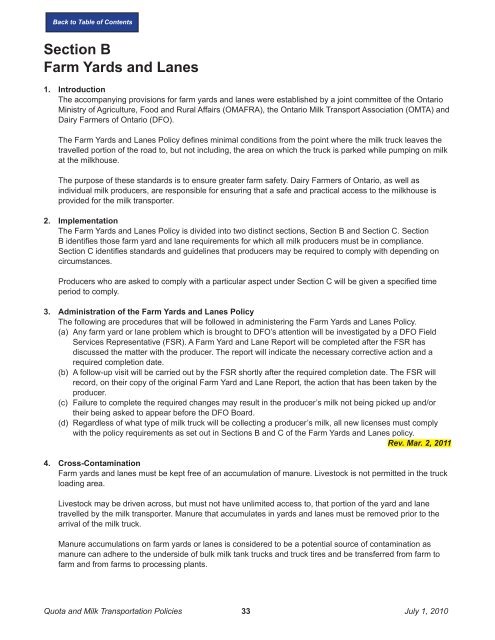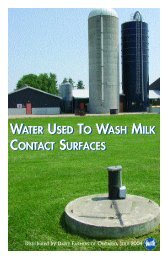English - Dairy Farmers of Ontario
English - Dairy Farmers of Ontario
English - Dairy Farmers of Ontario
You also want an ePaper? Increase the reach of your titles
YUMPU automatically turns print PDFs into web optimized ePapers that Google loves.
Back to Table <strong>of</strong> ContentsSection BFarm Yards and Lanes1. IntroductionThe accompanying provisions for farm yards and lanes were established by a joint committee <strong>of</strong> the <strong>Ontario</strong>Ministry <strong>of</strong> Agriculture, Food and Rural Affairs (OMAFRA), the <strong>Ontario</strong> Milk Transport Association (OMTA) and<strong>Dairy</strong> <strong>Farmers</strong> <strong>of</strong> <strong>Ontario</strong> (DFO).The Farm Yards and Lanes Policy defines minimal conditions from the point where the milk truck leaves thetravelled portion <strong>of</strong> the road to, but not including, the area on which the truck is parked while pumping on milkat the milkhouse.The purpose <strong>of</strong> these standards is to ensure greater farm safety. <strong>Dairy</strong> <strong>Farmers</strong> <strong>of</strong> <strong>Ontario</strong>, as well asindividual milk producers, are responsible for ensuring that a safe and practical access to the milkhouse isprovided for the milk transporter.2. ImplementationThe Farm Yards and Lanes Policy is divided into two distinct sections, Section B and Section C. SectionB identifies those farm yard and lane requirements for which all milk producers must be in compliance.Section C identifies standards and guidelines that producers may be required to comply with depending oncircumstances.Producers who are asked to comply with a particular aspect under Section C will be given a specified timeperiod to comply.3. Administration <strong>of</strong> the Farm Yards and Lanes PolicyThe following are procedures that will be followed in administering the Farm Yards and Lanes Policy.(a) Any farm yard or lane problem which is brought to DFO’s attention will be investigated by a DFO FieldServices Representative (FSR). A Farm Yard and Lane Report will be completed after the FSR hasdiscussed the matter with the producer. The report will indicate the necessary corrective action and arequired completion date.(b) A follow-up visit will be carried out by the FSR shortly after the required completion date. The FSR willrecord, on their copy <strong>of</strong> the original Farm Yard and Lane Report, the action that has been taken by theproducer.(c) Failure to complete the required changes may result in the producer’s milk not being picked up and/ortheir being asked to appear before the DFO Board.(d) Regardless <strong>of</strong> what type <strong>of</strong> milk truck will be collecting a producer’s milk, all new licenses must complywith the policy requirements as set out in Sections B and C <strong>of</strong> the Farm Yards and Lanes policy.Rev. Mar. 2, 20114. Cross-ContaminationFarm yards and lanes must be kept free <strong>of</strong> an accumulation <strong>of</strong> manure. Livestock is not permitted in the truckloading area.Livestock may be driven across, but must not have unlimited access to, that portion <strong>of</strong> the yard and lanetravelled by the milk transporter. Manure that accumulates in yards and lanes must be removed prior to thearrival <strong>of</strong> the milk truck.Manure accumulations on farm yards or lanes is considered to be a potential source <strong>of</strong> contamination asmanure can adhere to the underside <strong>of</strong> bulk milk tank trucks and truck tires and be transferred from farm t<strong>of</strong>arm and from farms to processing plants.Quota and Milk Transportation Policies 33 July 1, 2010
















